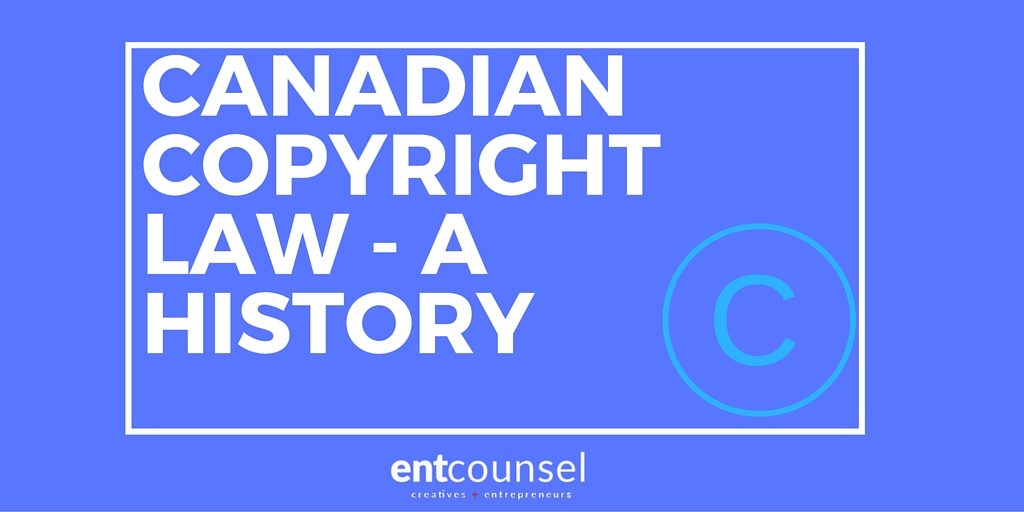The following article summarizes a history of Canadian copyright law and legislation in Canada from 1924 until the present day reviewing Bills, Legislations and Case Law. A list of all the important Canadian case law on Copyright Law is also summarized.
Canadian copyright law falls under Federal jurisdiction pursuant to section 91(23) of the Constitution Act of 1867. The Canadian Copyright Act is based on the United Kingdom Copyright Act, 1911, and came into force on January 1, 1924. Since that time, there have been many amendments with the first one happening in 1988 known as Bill C-60.
Origins of Canadian Copyright Law Legislation
Canadian copyright law and legislation provides a mechanism to ensure creators are compensated for use of their work in the marketplace and acknowledge the right of a copyright owner to control the use of their work.
Case law has held that the object and purpose of the Copyright Act is to benefit authors but that has evolved. Our current Act is based on the British Act of 1911. It was enacted in Canada in 1924, effective January 1, 1924. Principal amendments to the Copyright Act occurred in 1988 and 1997 known as “Phase One” and “Phase Two” respectively.’
The Act received its first major amendment in 1988 during “Phase One” Copyright Reform which established the use of copyright collectives and the formation of the Copyright Board (also moral rights, three-dimensional reproduction, computer programs).
“Phase Two” brought on the second wave of amendments which were implemented in Bill C-32. Bill C-32 was assented to on April 25, 1997, and introduced provisions relating to new remedies and new library exceptions which will be discussed later. All of the provisions of Bill C-32 are now in effect.
“Phase Three” – will address issues raised by new technologies and the new communications environment including the Information Highway. Canadian copyright law provides a mechanism to ensure creators are compensated for use of their work in the marketplace and acknowledge the right of a copyright owner to control the use of their work.
Originally, case law on copyright law has held that the object and purpose of the Copyright Act is to benefit authors. It is now designed to protect creators but also promote access to copyright-protected works. Our current Act is based on the British Act of 1911. It was enacted in Canada in 1924, effective January 1, 1924. See full text of the Act here to see what Copyright Law at that time. When this Act came into force, Canada adopted life plus 50 as the basic copyright term. On April 10, 1928, The Berne Convention for the Protection of Literary and Artistic Works comes into force in Canada.
Canadian Copyright Law Amendments “Phase One” (Bill C-60) & “Phase Two”(Bill C 32)
The principal amendments to Canadian copyright law occurred in 1988 and 1997 known as Phase One and Phase Two (Bill C 32) respectively. The Act received its first major amendment in 1988 during Phase One Copyright Law Reform which established the following Amendments:
- moral rights
- a new procedure to provide licenses for situations where the copyright owner cannot be located
- the abolition of compulsory licenses for the recording of musical works (a copyright owner could charge a royalty if someone wanted to use their work); and
- measure to improve the collective administration of copyright
- increased criminal sanctions
- established use of copyright collectives
- the creation and formation of a new Copyright Board
- enhanced moral rights
- explicit protection of computer programs
- an exhibition right for artistic works
- right to exhibit artistic works in public
- protection of choreographic works
- relationship of copyright and industrial design legislation
- anti-piracy remedies
- computer programs
- three-dimensional reproduction
- moral rights
Canadian Copyright Law Amendments after Passing of the Canada-U.S. Free Trade Agreement (1989-1994)
- January 1989 – Amendments to the Copyright Act were passed after the signing of the Canada-U.S. Free Trade Agreement and the North American Free Trade Agreement (NAFTA) so that Canada would be in compliance.
- The Amendments to our copyright laws now required Canadian cable and satellite companies to pay for the retransmission of work including distant broadcast signals. The definition of “communication to the public” was expanded from broadcasting to include all forms of telecommunication.
- Bill C-88 passed in 1993
- redefined “musical work” as covering both graphics and acoustic representations of music. The definition of “musical work” was amended by Bill C-88.
- Retransmission right of musical works also added to copyright law. Amendment to ensure that broadcasters, specialty, pay service or cable system transmitters were liable for royalties.
- In addition, certain administrative sections were also amended by the Intellectual Property Improvement Act.
- January 1, 1994
- The Copyright Act was amended to include a rental right (which permits a copyright owner to permit or prohibit the rental of their works) for sound recordings and computer programs. A rental right (which permits a copyright owner to permit or prohibit the rental of their works) for sound recordings and computer programs.
- The amendments also changed current copyright law and increased the protection for importing infringing works whether literary, musical or dramatic.
- Introduced retransmission right and compensation for retransmission right
- It also increased the protection for importing infringing works whether literary, musical or dramatic
WIPO Treaties – 1996 Canadian Copyright Law Amendments
- January 1, 1996 – WIPO Treaties – Amendments in the World Trade Organization Agreement Implementation Act extended copyright protected under the Copyright Act to all World Trade Organization (WTO) countries.
- These were made in order for Canada to comply with its obligations for the Trade-Related Intellectual Property Rights (TRIPs) of the General Agreement on Tariffs and Trade (GATT).
- These Treaties address the issue of copyright protection in the new digital environment which were signed by the Government of Canada in December 1997. Therefore, Canada needed to amend the Copyright Act in order to comply.
- The World Intellectual Property Organization (WIPO) Diplomatic Conference on Certain Copyright and Neighbouring Rights Questions adopted two treaties, namely the WIPO Copyright Treaty and the WIPO Performances and Phonograms Treaty on December 20, 1996 in Geneva.
- Performers received protection against unauthorized audio recordings and live transmissions of their performance.
Phase Two (Bill C 32) – 1997
- Phase Two brought on the second wave of amendments which were implemented in Bill C-32. Bill C-32 was assented to on April 25, 1997, and introduced provisions to the Copyright Act relating to:
- new remedies of statutory damages
- new library, non-profit educational institutions, archives and museums and other limited exceptions
- neighbouring rights protection for performers and producers of sound recordings (including payments for their sound recordings when broadcast or performed in public).
- the private copying regime.
- blank audio recording media levies paid to performers, producers and authors for private copying of their works making such copying legal
- exceptions for broadcasters to make temporary copies of events or performances that were to be broadcast at a later time
- exclusive book distributed given enhanced protection
- extension of rental rights to composers, lyricists and performers of musical works
- unpublished works given copyright protection for a term of the life of the author plus 50 years
- copyright term for the copyright in photographs changed to life of the author plus 50 years
- Allowed ratification of Rome Convention for the Protection of Performers, Producers of Phonograms and Broadcasting Organizations.
- Phase Two brought on the second wave of amendments which were implemented in Bill C-32. Bill C-32 was assented to on April 25, 1997, and introduced provisions relating to new remedies of statutory damages, new library and other limited exceptions, neighbouring rights protection for performers and producers of sound recordings and the private copying regime.
- 1997 – Tele-Direct (Publications) Inc. v. American Business Information, Inc. (C.A.), 1997 CanLII 6378 (F.C.A) – clarified database copyright in Canada and that copyright subsists in the original work and not the compilation of data unless it qualifies as an “original intellectual creation”.
Phase Three – A Framework for Copyright Reform – 2001
- Phase Three addressed issues raised by new technologies and the new communications environment including the Information Highway.
- June 2001 – A Framework for Copyright Reform
- Citizens
- Government
- A Framework for Copyright Reform
- Consultation Paper on Digital Copyright Issues
- Summary of Written Stakeholder Submissions
- June 2001 – A Framework for Copyright Reform
- March/April 2002 – Cross-Canada consultation meetings on Digital Copyright Issues
- March 28, 2002 – Theberge v. Galerie d’Art du Petit Champlain inc., 2002 SCC 34
- concerning the competition interest of the copyright owner and owner of the physical property for which copyright attaches
- October 3, 2002: Supporting Culture and Innovation: report on the Provisions and Operation of the Copyright Act (Section 92 Report)
- Government
- Supporting Culture and Innovation: Report on the Provisions and Operation of the Copyright act which discusses the governments’ recommendations on copyright reform to protect copyright but also provide access to and use of works… See also the summary here.
- Copyright and the Educational Use of Internet Content (Dec 8, 2003 working group report)
- NGO
- Public Interest Advocacy Centre (PIAC) submission
- Government
Bill C-11 – 2002 (Canada’s Retransmission Regime)
- “Retransmission Regime” – Legislation (Bill C-11) amending Canada’s retransmission regime for over-the-air broadcast signals was introduced in December 2001. It received royal assent in 2002.
- Retransmitters that were subject to the CRTC “New Media Exemption Order” were excluded from a compulsory licence.
- Retransmitters that were subject to the CRTC “New Media Exemption Order” were excluded from a compulsory licence.
- The Federal Government was provided with regulation-making powers to impose conditions of service on such retransmitters so they may no longer be subject to the exemption order in the future.
- The Federal Government was provided with regulation-making powers to impose conditions of service on such retransmitters so they may no longer be subject to the exemption order in the future.
- “Bill C-36” – An Act to establish the Library and Archives of Canada, to amend the Copyright Act and to amend certain Acts in consequence. It dies on the order paper on Nov 28, 2005.
- “Bill C-59” passed June 2007 – amended the Criminal Code to address illegal recording of films in movie theatres and making it an offence to record a film in a movie theatre without the consent of the theatre owner. The penalties are fine or jail.
- copyright amendments were dropped due to Dec 2003 deadline for unpublished posthumous works entering into the public domain. Bill didn’t pass Senate by end of 2003 and passed as Bill C-8.
- copying published works, fair dealing and defencescase initiated when I worked as legal counsel at Access Copyright
- “Bill C-60” and “Bill C-61” were tables on June 2005 but died on the order paper after the dissolution of Parliament.
-
- March 31, 2004 – BMG Canada Inc. and others v. Doe and others
- legality of Internet file sharing
- June 30, 2004 – Society of Composers, Authors and Music Publishers of Canada v. Canadian Association of Internet Providers 2004 SCC 45
- ISPs as common carriers
- Status of caches
- May 19, 2005 – Appears of BMG Canada Inc. and others v. Doe and others 2005 FCA 193
- legality of Internet file sharing
- March 31, 2004 – BMG Canada Inc. and others v. Doe and others
Bill C-59 – Amending the Criminal Code – 2007
-
- “Bill C-59” passed June 2007 – amended the Criminal Code to address illegal recording of films in movie theatres and making it an offence to record a film in a movie theatre without consent of the theatre owner. The penalties are fine or jail.
- “Bill C-60” and “Bill C-61” were tabled on June 2005 but died on the order paper after dissolution of Parliament.
- April 24, 2009 – Bill C-27 tabled and dies on order paper on December 30, 2009
- July 20, 2009 to September 13, 2009 – Public consultations on copyright
- Copyright and You, Test of Time, Innovation and Creativity, Competition and Investment, Digital Economy
- March 16, 2010 – Charlie Angus tables C-499 to extend existing private copying regime for recorded music to “audio recording devices”.
- May 14, 2010 – Society of Composers, Authors and Music Publishers of Canada c. Bell Canada, 2010 CAF 123
- looked at question of fair dealing and whether the Copyright Board was right in permitting a website selling digital music files to offer a 30 second clip for free to consumers (fair dealing for research purposes)? SOCAN challenged the Copyright Board and went to federal court to review the decision.
- May 25, 2010 Ministry of Industry tables Bill C-28 The Anti-Spam Bill (new name from old Bill C-27 which was called the Electronic Commerce Protection Act).
- See Michael Geist’s blog post here where he says it’s the same bill new name.
The Copyright Modernization Act (CMA) – Further Canadian Copyright Law Amendments
- The Copyright Modernization Act is known as Bill C-11 and formerly Bill C-32 and introduced in 2010
- “Bill C-32” introduced June 2, 2010 ontroduced by the Government of Canada to introduce legislation to modernize the Copyright Act and bring it in line with international standards.
- Information on the new provisions can be found on the copyright modernization website. Prior to this, the government launched national consultations on July 20, 2009 to get the public’s view of proposed reforms to the Copyright Act after Bill C-61. Bill C-32 dies on the order paper when the 41st General Election is called.
- September 29, 2011 – Ministry of Industry tables Bill C-11 (same bill previously Bill C-32).
- June 29, 2012 – Bill C-11 receives Royal Assent and most coming into effect on November 7, 2012
- IPS and search engines exempt from liability when acting as intermediaries and “Notice and Notice” provisions implemented obligating ISPs to notify their customers if they are alleging infringing copyright
- infringement actions for peer to peer file sharing when individuals should know that such sites are created to infringe copyright
- Fair dealing expanded to include education, parody and satire
- a distinction made between commercial and non-commercial infringement for statutory damages
- reproduction for private purposes is permitted such as copying music you already legally own for copying onto your own computer, or music player etc.
- time-shifting of a recording of communication signals or programs for a private purpose is now permitted
- the use of existing works permitted when making a new work such as a mash-up and post such work online
- Those with perceptual disabilities are permitted to adapt copyright works acquired legally
- Libraries, archives and museums permitted to digitize and copy materials in an alternative format if there is a danger that the original may become obsolete. Further, interlibrary loans in digital form are permitted.
- certain educational uses permitted by teachers in using contents over the Internet
- The removal or tampering of copyright information on works prohibited
- The removal or tampering with digital rights management (DRM) on content is prohibited
- Photographers are now the first owner of copyright in their photographs even when commissioned by a third party
- Duration of copyright in sound recordings extended
- New rights such as making available and distribution as set out in the digital World Intellectual Property Organization (WIPO) treaties.
Read more about the Copyright Modernization Act.
- July 12, 2012 – Major Supreme Court of Canada Decisions affecting copyright law
- Re:Sound v. Motion Picture Theatre Associations of Canada, 2012 SCC 38
- Alberta (Education) v. Canadian Copyright Licensing Agency (Access Copyright), 2012 SCC 37
- Rogers Communications Inc. v. Society of Composers, Authors and Music Publishers of Canada 2012 SCC 35
- Entertainment Software Association v. Society of Composers, Authors and Music Publishers of Canada, 2012 SCC 34
(by Vandana Taxali/Copyright Entcounsel 2018)



